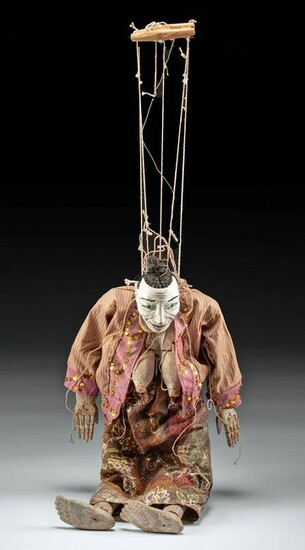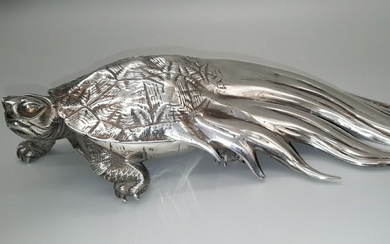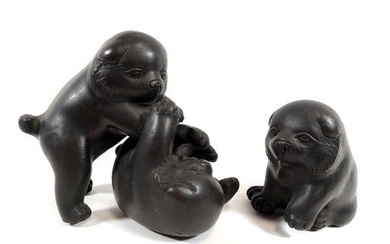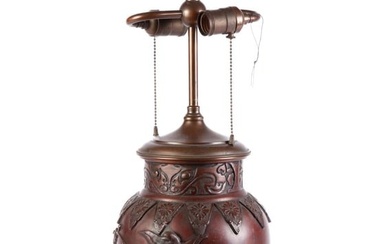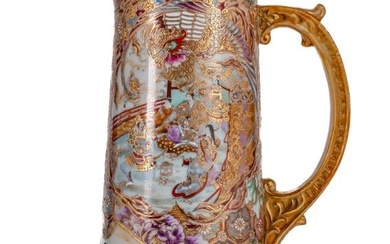Early 20th C. Japanese Articulated Wood Marionette
**Originally Listed At $250**
East Asia, Japan, ca. early to mid-20th century CE. A wonderful carved-wood marionette dressed in a tunic and skirt of silken cloth. The intriguing figure displays a long body and jointed arms and legs with intricately delineated fingers and toes, all attached to marionette strings. A pair of drooping breasts protrude from the figure's square torso, featuring large nipples that are also attached to strings. Hand-painted white with black, red, and pink details, her expressive visage presents triangular eyes beneath straight brows, a naturalistic nose, high cheek bones, and a smiling mouth with the ability to open and close, all capped with a black coiffure of horsehair tied into a top bun. Her tunic showcases shades of violet and puce with lustrous golden sequins, while her skirt exhibits a lovely floral pattern of russet, olive, sienna, puce, black, and white. Size: 25" arm span x 21" H (63.5 cm x 53.3 cm)
Bunraku is a Japanese traditional form of puppet theater. Puppeteers used doll-puppets to chant a dramatic narrative known as joruri with musical accompaniment on a samisen (three stringed lute). The term Bunraku comes from the name of a puppeteer troupe founded by Uemura Bunrakuken in the early 19th century. Several puppeteers are needed to operate each puppet. Traditionally, the primary handler dons 18th century attire and operates the puppet's head and right hand, moving eyes, eyebrows, lips, as well as fingers. A pair of assistants, dressed in black, in order to blend into the background and not detract from the puppets, operate the hands, legs, and feet. Extensive training is necessary in order to attain synchronized motion and lifelike gestures and emotions during the performance. UNESCO identified Bunraku as a Masterpiece of Oral and Intangible Heritage of Humanity in 2003.
Provenance: ex-Stein collection, Bloomfield Hills, Michigan, USA, acquired prior to 2010
All items legal to buy/sell under U.S. Statute covering cultural patrimony Code 2600, CHAPTER 14, and are guaranteed to be as described or your money back.
A Certificate of Authenticity will accompany all winning bids.
PLEASE NOTE: Due to recent increases of shipments being seized by Australian & German customs (even for items with pre-UNESCO provenance), we will no longer ship most antiquities and ancient Chinese art to Australia & Germany. For categories of items that are acceptable to ship to Australia or Germany, please contact us directly or work with your local customs brokerage firm.
Display stands not described as included/custom in the item description are for photography purposes only and will not be included with the item upon shipping.
#164350
Condition Report: Nicks and abrasions throughout, commensurate with age and use. Otherwise, intact and excellent with lovely remaining pigments.
View it on
Estimate
Time, Location
Auction House
**Originally Listed At $250**
East Asia, Japan, ca. early to mid-20th century CE. A wonderful carved-wood marionette dressed in a tunic and skirt of silken cloth. The intriguing figure displays a long body and jointed arms and legs with intricately delineated fingers and toes, all attached to marionette strings. A pair of drooping breasts protrude from the figure's square torso, featuring large nipples that are also attached to strings. Hand-painted white with black, red, and pink details, her expressive visage presents triangular eyes beneath straight brows, a naturalistic nose, high cheek bones, and a smiling mouth with the ability to open and close, all capped with a black coiffure of horsehair tied into a top bun. Her tunic showcases shades of violet and puce with lustrous golden sequins, while her skirt exhibits a lovely floral pattern of russet, olive, sienna, puce, black, and white. Size: 25" arm span x 21" H (63.5 cm x 53.3 cm)
Bunraku is a Japanese traditional form of puppet theater. Puppeteers used doll-puppets to chant a dramatic narrative known as joruri with musical accompaniment on a samisen (three stringed lute). The term Bunraku comes from the name of a puppeteer troupe founded by Uemura Bunrakuken in the early 19th century. Several puppeteers are needed to operate each puppet. Traditionally, the primary handler dons 18th century attire and operates the puppet's head and right hand, moving eyes, eyebrows, lips, as well as fingers. A pair of assistants, dressed in black, in order to blend into the background and not detract from the puppets, operate the hands, legs, and feet. Extensive training is necessary in order to attain synchronized motion and lifelike gestures and emotions during the performance. UNESCO identified Bunraku as a Masterpiece of Oral and Intangible Heritage of Humanity in 2003.
Provenance: ex-Stein collection, Bloomfield Hills, Michigan, USA, acquired prior to 2010
All items legal to buy/sell under U.S. Statute covering cultural patrimony Code 2600, CHAPTER 14, and are guaranteed to be as described or your money back.
A Certificate of Authenticity will accompany all winning bids.
PLEASE NOTE: Due to recent increases of shipments being seized by Australian & German customs (even for items with pre-UNESCO provenance), we will no longer ship most antiquities and ancient Chinese art to Australia & Germany. For categories of items that are acceptable to ship to Australia or Germany, please contact us directly or work with your local customs brokerage firm.
Display stands not described as included/custom in the item description are for photography purposes only and will not be included with the item upon shipping.
#164350
Condition Report: Nicks and abrasions throughout, commensurate with age and use. Otherwise, intact and excellent with lovely remaining pigments.
